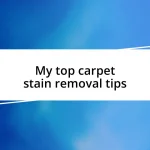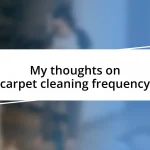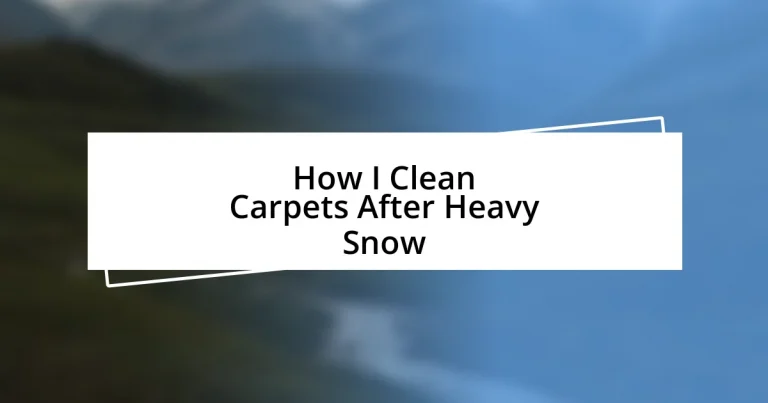Key takeaways:
- Heavy snow can lead to carpet damage through moisture and mold growth, requiring immediate attention to prevent health risks and stains.
- Effective carpet care involves thorough assessments for discoloration and dampness, followed by prompt removal of snow and ice residue to maintain carpet integrity.
- Implementing preventive measures, such as designated snow removal areas and using absorbent mats, significantly reduces future carpet damage from winter weather.

Understanding Carpet Damage Risks
When heavy snowflakes fall, it’s easy to overlook the havoc they can wreak on our carpets. I recall a winter when I didn’t think much about snow melting indoors; a few days later, I discovered my carpet not just damp but also starting to smell faintly musty. Isn’t it alarming how quickly a seemingly minor issue can escalate?
The moisture from melted snow can lead to mold growth, which often goes unnoticed until it’s too late. Imagine the horror of pulling back a corner of your carpet to reveal dark spots. It’s not just a visual nightmare; mold can also affect air quality and your family’s health. If you’ve ever struggled with allergies, this is a risk you can’t afford to ignore.
Then there’s the risk of staining. Snow often carries dirt, salt, and a slew of other contaminants that can embed themselves in your carpet fibers. Have you experienced the disappointment of finding a stubborn stain you thought you could scrub away? Prevention and prompt action can make all the difference in protecting your carpets from the aftermath of winter weather.

Initial Assessment of Carpet Condition
Assessing the condition of your carpet after a heavy snow is the first step towards effective cleaning. I remember a time when I thought a simple vacuum would do the trick, only to find that my carpet had subtle damp spots hidden beneath the surface. When you take a closer look, signs of water damage can be easily overlooked, so I now make it a habit to perform a thorough visual inspection.
During this assessment, I usually check for discoloration and texture changes. I was surprised at how one corner of my carpet had turned uneven and frayed after snow was tracked in repeatedly. Did you know that even moisture trapped deep within the fibers can cause them to lose their original structure? It’s essential to identify these issues before diving into cleaning methods.
Taking the time to evaluate your carpet can save you a lot of hassle in the long run. I’ve learned to feel the carpet for dampness actively and check for any lingering odors, which can indicate hidden mildew. It’s all about being proactive, rather than reactive. Remember, our carpets do so much for our homes; let’s take care of them like they deserve!
| Condition Signs | What to Look Out For |
|---|---|
| Moisture | Damp spots or wetness upon inspection |
| Staining | Any discoloration or visible dirt |
| Texture Changes | Unevenness or fraying |
| Odors | Musty or mildew smell |

Removing Snow and Ice Residue
Once winter’s chill begins to thaw, tackling the residual mess is crucial. I remember vividly the first time I stepped inside after a heavy snow, only to see tiny ice crystals melting into a slippery pool on my carpet. It’s a sobering reminder of how quickly snow can transition from a winter wonderland to a soggy inconvenience. To effectively remove snow and ice residue from carpets, I adhere to a few essential steps:
- Blot the excess moisture with clean, absorbent towels to prevent deeper soaking.
- Gently scrape away any ice chunks to avoid damaging the carpet fibers.
- Utilize a carpet cleaner or a foaming spray with a neutral pH to break down residues. Always test on a small, hidden area first.
- Ensure ample ventilation in the room to speed up drying time and reduce mustiness.
Taking care to remove all snow and ice residue not only preserves the carpet’s integrity but also helps eliminate any lurking odors. One time, I missed this step and was greeted by a musty smell days later, which was simply heartbreaking. It’s vital to stay vigilant! The last thing you want is to end up battling mold, which I’ve learned, can pull apart even the best of carpets.

Drying Techniques for Wet Carpets
Drying wet carpets effectively can sometimes feel like a race against time. After a particularly messy snow season, I discovered that using fans and dehumidifiers simultaneously made a significant difference. The fans helped circulate air while the dehumidifier worked its magic, sucking up the moisture trapped in the carpet fibers. It’s surprising how much of a difference these tools can make in speeding up the drying process.
I remember a time when I was too impatient and skipped this crucial step. I relied on just opening windows and hoping the sun would do its job. Unfortunately, that left my carpet damp for days and led to some unsavory mold growth. Now, I always remind myself that moisture must be dealt with swiftly – the sooner I act, the less likely I am to face bigger challenges down the road.
Another technique that I’ve found really effective is using towels to absorb excess moisture. I often dampen a clean, absorbent towel and press it against wet areas, allowing it to soak up as much water as possible. It’s fascinating how much moisture a simple towel can absorb! Have you ever thought about how something so commonplace can be a hero in times of crisis? Each little step adds up and keeps my carpets looking and smelling fresh.

Choosing the Right Cleaning Products
Choosing the right cleaning products can make a world of difference in restoring your carpets after they’ve endured heavy snow. I’ve always found that opting for eco-friendly solutions not only helps the environment but also keeps my home safe from harsh chemicals. It’s amazing how knowing this provides peace of mind—especially when you have little ones or pets darting around the house. Have you ever thought about how the products you use affect your family’s health?
In my journey of experimenting with various cleaners, I discovered that enzymatic cleaners work wonders for breaking down stubborn residues left behind by snow and ice. There was a time I used a regular carpet cleaner, and while it did the job initially, lingering odors soon crept back in. That experience taught me the importance of digging deeper into product labels and understanding what each ingredient does. Sometimes, the right product can be a game-changer, turning a daunting cleaning task into a smoother one.
Additionally, I always carry out a patch test before fully committing to any cleaning solution. I made the mistake once of using a bright, promising cleaner without testing it first, which led to a discolored spot on my favorite rug. It’s moments like these that remind me to pause and proceed with caution—because once damage is done, it can be hard to reverse. Trust me, taking that extra step can save you a headache down the line!

Deep Cleaning Methods for Carpets
Deep cleaning carpets after a harsh winter often requires a bit more effort than usual, and I’ve found that steam cleaning can be a true lifesaver. Recently, I grabbed my steam cleaner and was amazed at how the hot steam penetrated the fibers, lifting dirt and allergens with ease. It felt almost therapeutic to watch the grime dissipate into the machine — like giving my carpets a much-needed spa day. Have you ever watched your carpets transform right before your eyes?
In addition to steam cleaning, I occasionally whip out my trusty carpet shampooer. It’s quite the investment, but I’ve learned that the combination of hot water and a quality carpet shampoo can break down stubborn stains caused by snowmelt. One time, I was heartbroken over a dark mark left by my dog, but after a thorough shampoo session, it vanished like a magician’s trick! It’s so rewarding to witness these dramatic results; I often find myself smiling as I reflect on how a little effort can yield such a satisfying outcome.
I’ve also dabbled in the world of homemade cleaning solutions for that extra touch of personalization. For instance, mixing vinegar and baking soda creates a powerful, natural cleaner that can tackle tough spots without the harsh chemicals. I remember when I first experimented with this combo — I was pleasantly surprised that something so ordinary could produce such effective results. Who knew that a sprinkle of baking soda could bring back the vibrancy of my carpet’s colors? It makes me think, are we missing out on other simple solutions in our cleaning routines?

Preventing Future Snow Damage
To prevent future snow damage to your carpets, one of the most effective strategies is to establish a designated snow removal area near your entrance. I remember when I first set up a small mat outside my door—it felt like a game-changer. Every time I came in from the wintry outdoors, my shoes had a much better chance of shedding the bulk of the snow and ice before they even made it into my home. Have you ever considered how creating a simple barrier could save you countless cleaning hours?
Another vital step is investing in quality door mats—preferably ones with strong absorbent fibers. I’ve found that a well-chosen mat catches a substantial amount of moisture and dirt before it steps onto my carpets. There’s a particular mat I adore that not only complements my home décor but also makes me feel more at ease every time I see it capturing snowflakes. It’s fascinating how such a simple addition can have a huge impact on the overall cleanliness of your home.
Finally, regular maintenance is key. I set a reminder every couple of weeks to give my carpets a quick vacuum and inspection—even when there’s no snow in sight. By staying proactive, I can spot potential problem areas before they escalate. It’s all too easy to let little issues slip, and trust me, dealing with stubborn stains later on is far from enjoyable. How often do you take that extra step to protect your home from winter’s chill?














